Discover 35 hidden attractions, cool sights, and unusual things to do in Ghent (Belgium). Don't miss out on these must-see attractions: Belfry of Ghent, Saint Nicholas Church, and Design museum Gent. Also, be sure to include St Bavo's Cathedral in your itinerary.
Below, you can find the list of the most amazing places you should visit in Ghent (Vlaanderen).
Table of Contents
Belfry of Ghent
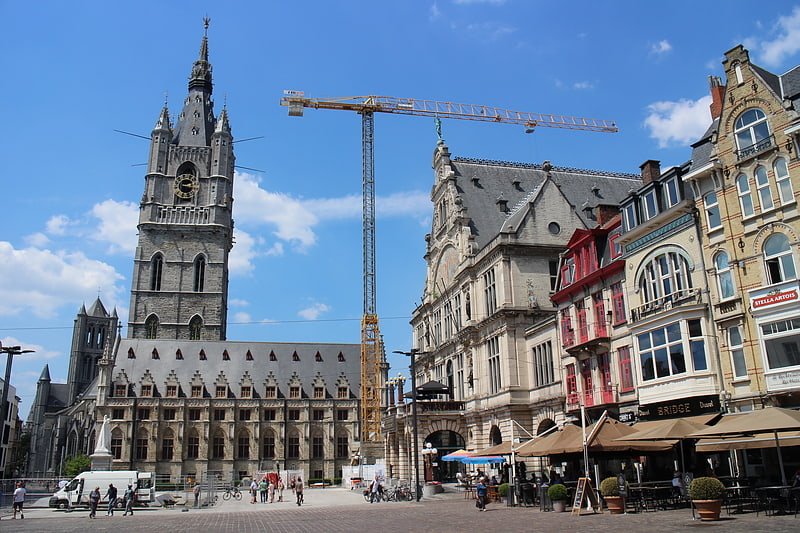
Also known as: Beffroi de Gand
14th-century belfry and watch tower. The 91-metre-tall Belfry of Ghent is one of three medieval towers that overlook the old city centre of Ghent, Belgium, the other two belonging to Saint Bavo Cathedral and Saint Nicholas' Church. Its height makes it the tallest belfry in Belgium. The belfry of Ghent, together with its attached buildings, belongs to the set of Belfries of Belgium and France, a UNESCO World Heritage Site.[1]
Address: Emile Braunplein 40, 9000 Gent (Binnenstad)
Saint Nicholas Church
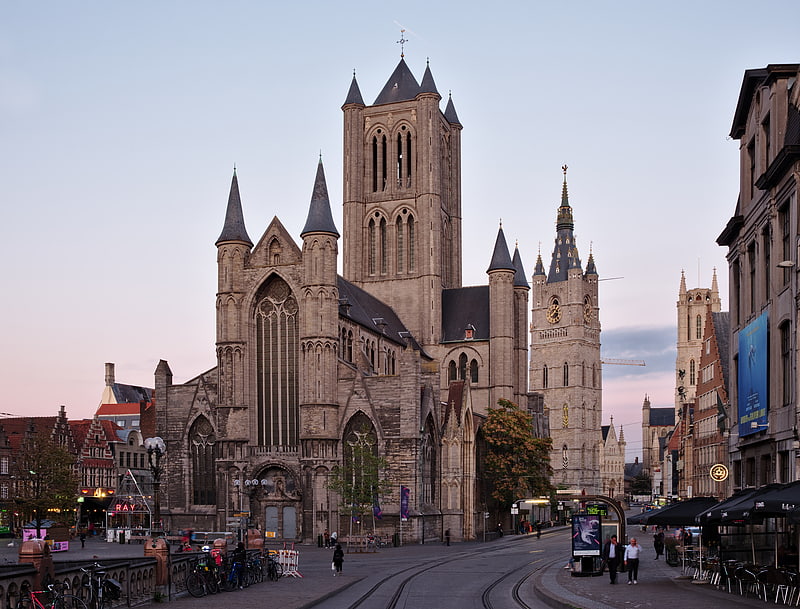
Also known as: Église Saint-Nicolas de Gand
Late Gothic church with rich interiors. St. Nicholas Church is one of the oldest and most prominent landmarks in Ghent, Belgium. Begun in the early 13th century as a replacement for an earlier Romanesque church, construction continued through the rest of the century in the local Scheldt Gothic style. Typical of this style is the use of blue-gray stone from the Tournai area, the single large tower above the crossing, and the slender turrets at the building's corners.
Built in the old trade center of Ghent next to the bustling Korenmarkt (Wheat Market), St. Nicholas Church was popular with the guilds whose members carried out their business nearby. The guilds had their own chapels which were added to the sides of the church in the 14th and 15th centuries.
The central tower, which was funded in part by the city, served as an observation post and carried the town bells until the neighboring belfry of Ghent was built. These two towers, along with the Saint Bavo Cathedral, still define the famous medieval skyline of the city center. One of the treasures of the church is its organ, produced by the famous French organ builder Aristide Cavaillé-Coll.[2]
Address: Cataloniestraat 4, 9000 Ghent (Binnenstad)
Design museum Gent
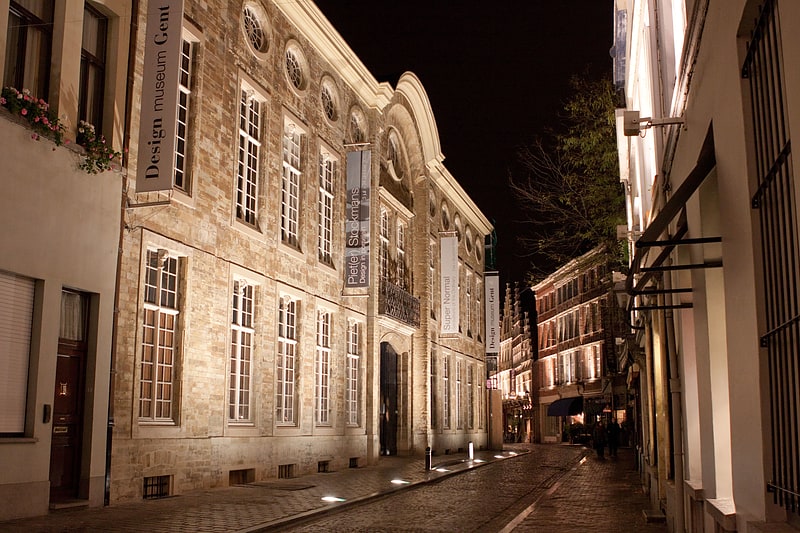
Also known as: Design Museum Gent
Museum in Ghent, Belgium. Design Museum Gent is the only museum in Belgium with an international design collection. The museum complex, situated in the heart of the tourist centre of Ghent, comprises an imposing 18th-century mansion and a modern wing. The museum possesses a comprehensive and trend-setting collection of Belgian design, supported by international top-class objects. Its collection includes everything from the Art Nouveau of Henry van de Velde to contemporary avant-garde design.[3]
Address: Jan Breydelstraat 5, 9000 Ghent (Sint-Elisabethbegijnhof-Prinsenhof-Papegaai-Sint-Michiels)
St Bavo's Cathedral
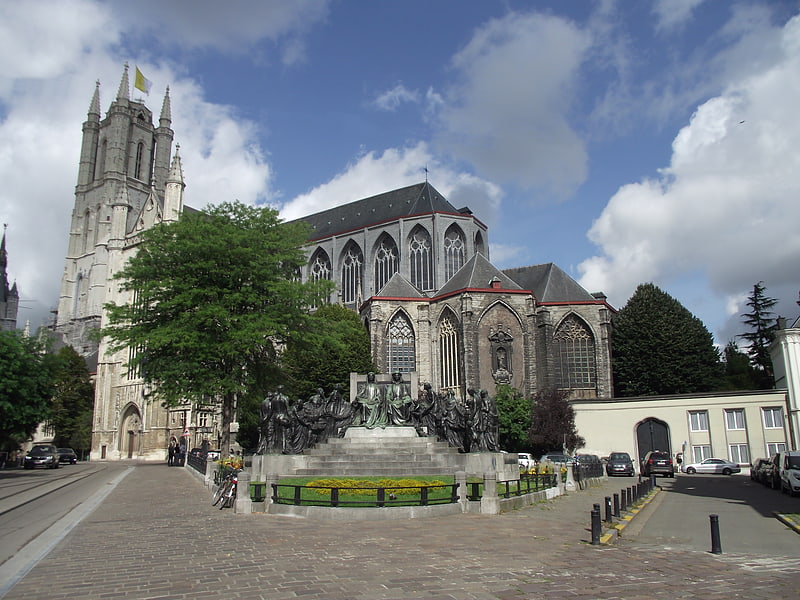
Also known as: Cathédrale Saint-Bavon de Gand
10th-century Romanesque cathedral. Saint Bavo's Cathedral, also known as Sint-Baafs Cathedral, is a cathedral of the Catholic Church in Ghent, Belgium. The 89-meter-tall Gothic building is the seat of the Diocese of Ghent and is named for Saint Bavo of Ghent. It contains the well-known Ghent Altarpiece.[4]
Address: Hoofdkerkstraat 1, 9000 Gent (Binnenstad)
Gravensteen

Also known as: Château des comtes de Flandre
10th-century castle with moat and views. The Gravensteen is a medieval castle at Ghent, East Flanders in Belgium. The current castle dates from 1180 and was the residence of the Counts of Flanders until 1353. It was subsequently re-purposed as a court, prison, mint, and even as a cotton factory. It was restored over 1893–1903 and is now a museum and a major landmark in the city.[5]
Address: Geldmunt 2, 9000 Gent (Binnenstad)
Ghelamco Arena
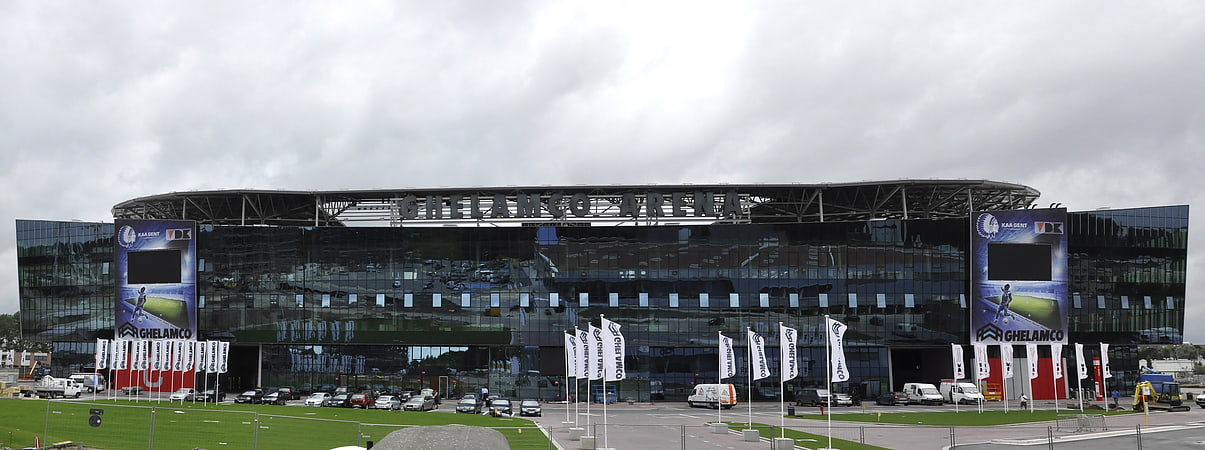
Stadium in Ghent, Belgium. The Ghelamco Arena is a multi-use stadium in Ghent, Belgium. It hosts the home matches of football club K.A.A. Gent and was officially opened on 17 July 2013, making it the first newly-built Belgian football stadium since 1974.
The stadium seats 20,000 and replaced the Jules Ottenstadion, which had been Gent's home since 1920. The stadium hosted its first competitive match on 4 August 2013, when Gent won 2-1 over KV Mechelen.[6]
Address: Ottergemsesteenweg-Zuid 808, 9000 Gent (Nieuw Gent-UZ)
Huis van Alijn

Also known as: Musée de la vie populaire
Museum in Ghent, Belgium. The Huis van Alijn is a museum located on the Kraanlei in Ghent, Belgium. The collection revolves around local culture and daily life in the 20th century.[7]
Address: Kraanlei 65, 9000 Ghent (Binnenstad)
Portus Ganda
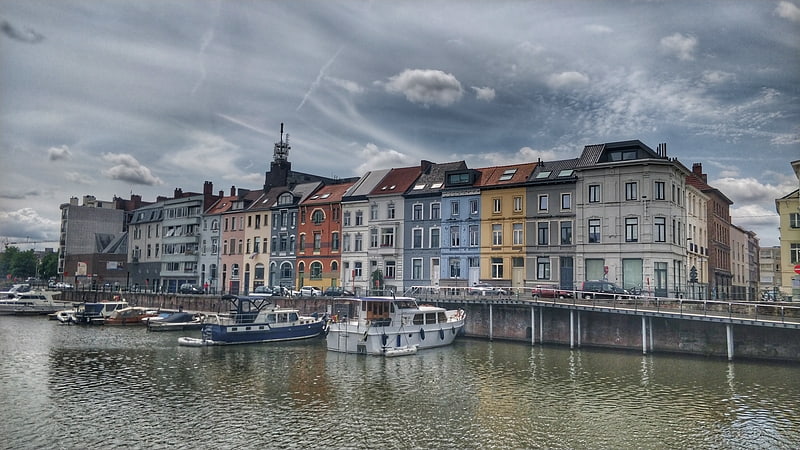
Port operating company in Ghent, Belgium. Portus Ganda is one of the yacht moorings provided by the city of Ghent in East Flanders, Belgium. Located at Veerkaai 2 at a crossing in the old waterways of the river Leie, it opened in 2005 to create a destination for people touring the Flemish waterways by boat. The harbour master's office is located next to the new entrance of the Van Eyck swimming pool that faces the Veermanplein.
The moorings provide hookups for water and electricity. Security is low as the docks are accessible from the shore.
For people wishing to explore Gent the city centre is in walking distance from the docks and for more immediate needs there are restaurants and shopping along the Kaiser Karel Straat.
The city website provides both Contact Information for the Harbour Master (in Flemish) and tourism information (in English)[8]
Address: Veermanplein 2, 9000 Ghent (Binnenstad)
Graslei
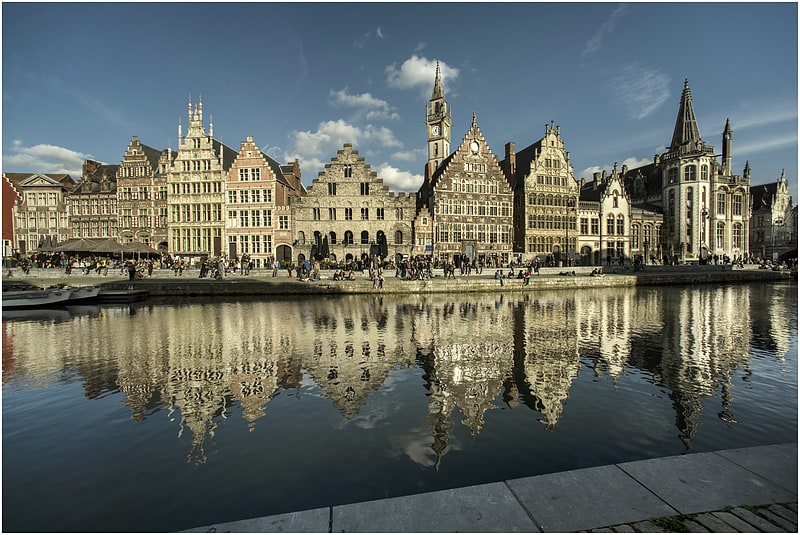
Graslei is a quay in the historic city center of Ghent, Belgium, located on the right bank of the Leie river. The quay opposite of the Graslei is called Korenlei. Both quays were part of the medieval port and are now a cultural and touristic hotspot of the city, with a high concentration of café patios. The site, with its unique row of historical buildings, is a protected cityscape.[9]
Address: Graslei en Korenleih, Ghent (Binnenstad)
Ghent City Museum
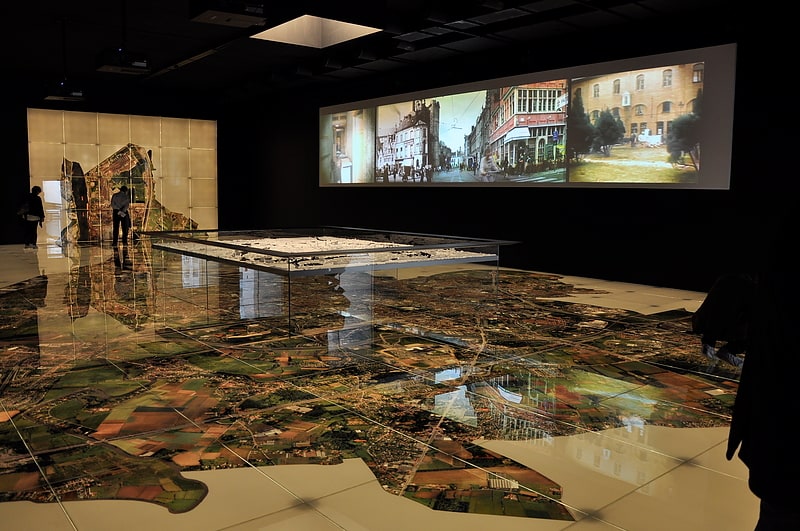
Also known as: Musée de la ville de Gand
Museum in Ghent, Belgium. The Ghent City Museum is a museum in the Belgian city of Ghent. The museum exposes the city history and opened its doors on 9 October 2010. With respect to the collection that is shown, the history of this museum goes back to 1833, the year in which the Oudheidkundig Museum van de Bijloke in Ghent was founded. In 1928 the museum was situated in the Bijloke abbey - this led to the name Bijlokemuseum.
With the Bijloke collection as base and the Bijloke abbey and Bijloke monastery as buildings, the STAM functions as a modern-day heritage forum. Parts from other collections were added to the Bijloke collection. In connection to the historical buildings a new entrance building was constructed, designed by Ghent's city architect Koen Van Nieuwenhuyse.
The main circuit of the Ghent City Museum serves as a museal and multimedial introduction to a visit to the city of Ghent. The past of the town is illustrated, but also today's life and the future are discussed. The temporary STAM collections describe the phenomenon of "urbanity" by means of contemporary issues. STAM refers the visitor to the city itself and to Ghent's cultural heritage. Chronologically structured rooms invite the visitors to explore various thematics. There is also a section dedicated to the Ghent Altarpiece.
The Ghent City Museum was the winner of the 2012 Flemish Museum Prize.[10]
Address: Godshuizenlaan 2, 9000 Ghent (Watersportbaan-Ekkergem)
Hotel d'Hane-Steenhuyse
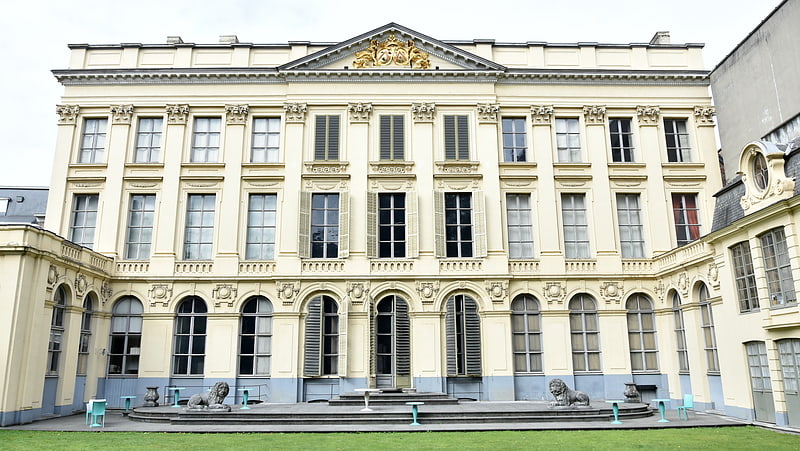
Museum in Ghent, Belgium. The Hotel d'Hane-Steenhuyse is an 18th-century city palace in the Belgian city of Ghent. It is located in the Veldstraat and was once a possession of the D'Hane de Steenhuyse family.[11]
Address: 55 Veldstraat, Ghent (Binnenstad)
Geeraard de Duivelsteen
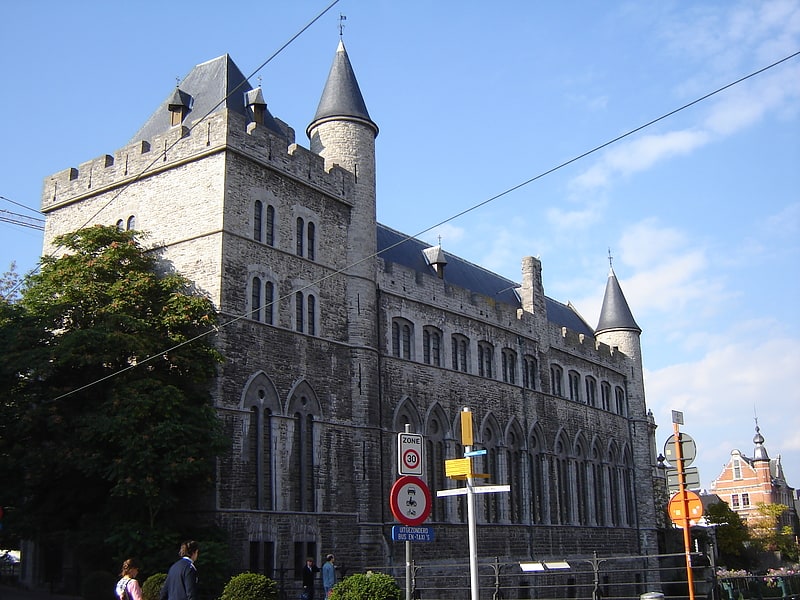
Also known as: Château de Gérard le Diable
Monument in Ghent, Belgium. The Geeraard de Duivelsteen is a 13th century gothic architecture building in Ghent, Belgium. It served as defense of the Portus Ganda, the city's port.[12]
Address: Geraard de Duivelstraat 1, 9000 Ghent (Binnenstad)
Korenmarkt
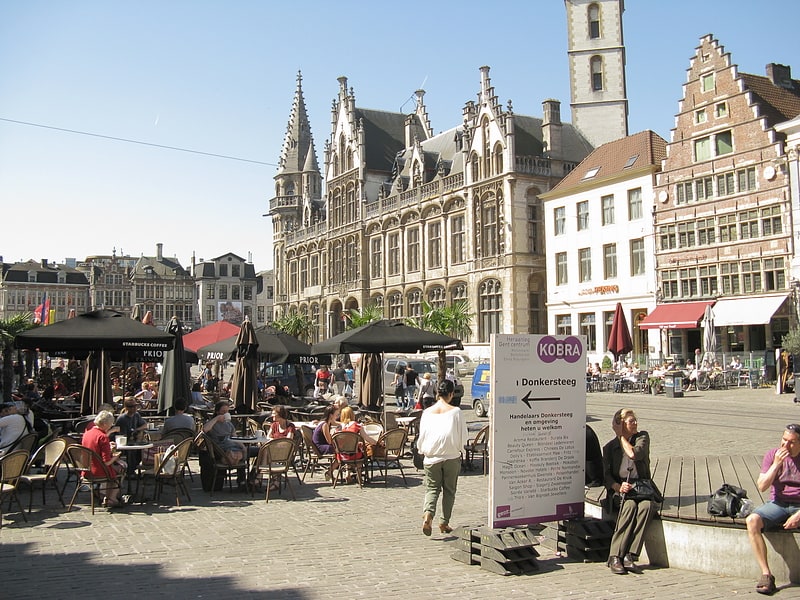
Tourist attraction in Ghent, Belgium. Korenmarkt is a city square in the historic center of Ghent, Belgium. Located between the Leie river and St. Nicholas' Church, it is one of the city's most important and famous tourist locations. The square is surrounded with several historic buildings, which today house bars, restaurants and terraces. It is a pivotal location of the annual Gentse Feesten cultural festival.[13]
Woodrow Wilsonplein
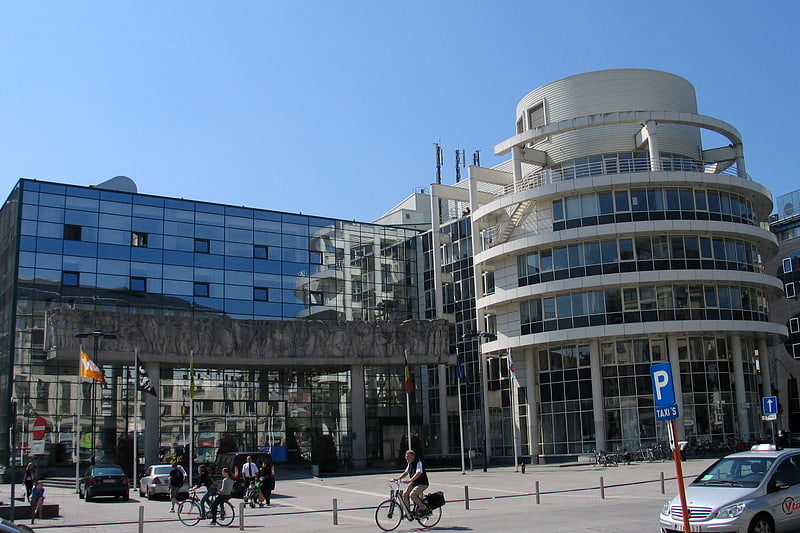
Woodrow Wilsonplein is a city square in the center of Ghent, Belgium. The square is colloquially called 't Zuid, after its location just south of the historical city center and the former train station Ghent-South. It is named after Woodrow Wilson, the 28th president of the United States and first US president to pay an official state visit to Belgium.
Woodrow Wilson Square is home to Ghent's largest shopping mall Ghent South, which also serves as an office complex. On the southside of the square is the city's main administrative center, the city library and a postal office. The Capitole, Ghent's largest theater and event venue, is separated from Woodrow Wilson Square by the Graaf van Vlaanderenplein. The square borders the northside of the Zuidpark (English: South Park; not to be confused with the American adult animated series of the same name).
In May 2020 the square's zebra crossing was transformed into a Rainbow crossing in order to create awareness and acceptance of LGBT diversity.[14]
King Albert Park
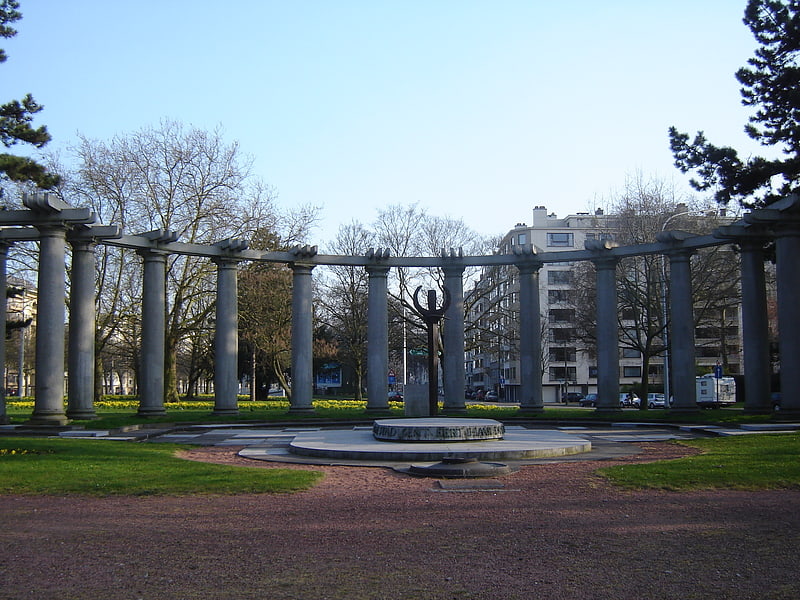
The Koning Albertpark, also known as Zuidpark, is a city park in the Belgian city of Ghent. The park is located in the southeast of the city center, between Woodrow Wilson Square and the B401 motorway exits that terminate at Zuidpark in the city. It is a neo-baroque park, where the other parks in the city are mostly laid out in English landscape style.
After the demolition of the Gent-Zuid train station in 1928, which was replaced by the Gent-Sint-Pieters railway station, a large elongated space became available. In the 1930s, the Zuidpark was built on these former railway sites. After the death of King Albert I in 1934, it was officially called King Albert Park.
A bust of Leopold II of Belgium stood in the park for many years. It was removed in 2020, as a result of the George Floyd protests in Belgium.[15]
Stadshal
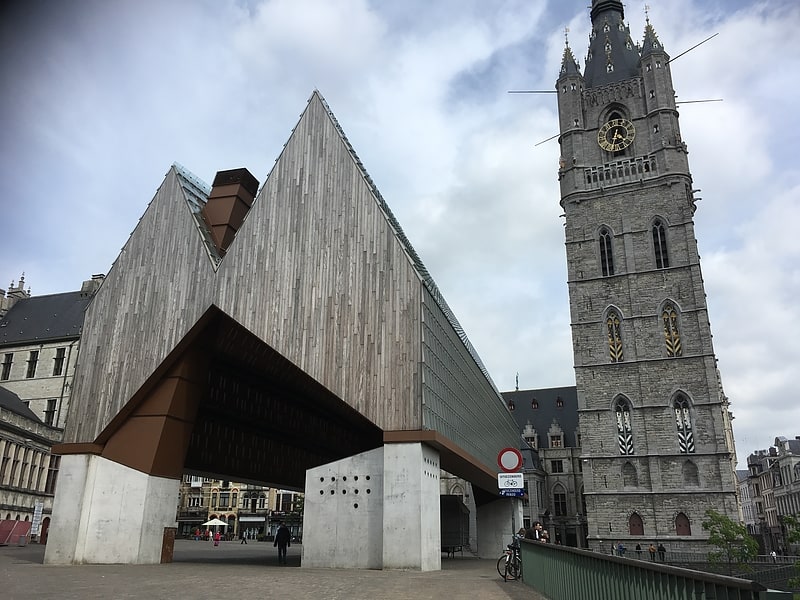
Also known as: Halle de Gand
Event venue in Ghent, Belgium. The Stadshal is a large stand-alone canopy in the inner city of Ghent, Belgium. The construction was part of the city project to redevelop the squares and public spaces in Ghent's historic city center. The Stadshal, located on the square between the belfry, the renaissance city hall and Saint Nicholas' Church, received criticism upon its construction in 2012, because of its size, height and use of modern materials in the historical surroundings.[16]
Address: Groentenmarkt 15B, 9000 Gent, Ghent (Binnenstad)
Museum of Fine Arts

Also known as: Musée des beaux-arts de Gand
Classical art museum in elegant building. The Museum of Fine Arts in Ghent, Belgium, is situated at the East side of the Citadelpark.
The museum's collection consists of some 9000 artworks, dating from the middle ages to the 20th century. Over 600 works can be found on display permanently, with the collection largely focusing on Flemish Art (Southern Netherlands). It also houses several European- especially French- paintings, in addition to a large amount of sculptures.
Next to its permanent collection the museum organises temporary exhibitions. Between March 2011 and January 2021, the museum conducted 41 exhibitions.
The building was designed by city architect Charles van Rysselberghe around 1900.
In 2007 the museum reopened after four years of restoration.
The museum is a member of The Flemish Art Collection. This is a structural partnership joining the three main museums of fine arts in Flanders: Royal Museum of Fine Arts, the Groeninge Museum in Bruges and the Ghent Museum of Fine Arts. The museums’ collections have all been developed in a similar way and complement each other perfectly. Together, they offer a unique, representative overview of Flemish art from the 15th to the 20th century. As partners sharing the same responsibility in Belgian cultural heritage, the three museums exchange their expertise, they strive for a more sustainable, high quality management and international awareness of their collections, including works that are part of the world patrimony.[17]
Address: Fernand Scribedreef 1, 9000 Gent (Stationsbuurt Noord)
Saint Michael's Church

Also known as: Église Saint-Michel de Gand
Large church with interior artwork. Saint Michael's Church is a Roman Catholic church in Ghent, Belgium built in a late Gothic style. It is known for its rich interior decoration.[18]
Address: Sint-Michielsplein 4, 9000 Gent (Sint-Elisabethbegijnhof-Prinsenhof-Papegaai-Sint-Michiels)
SMAK
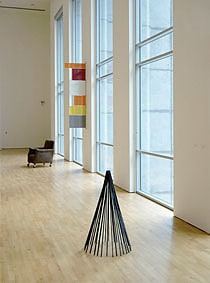
Also known as: Musée municipal d'art actuel
Contemporary art museum opened in 1999. The Stedelijk Museum voor Actuele Kunst is a relatively new museum located in Ghent, Belgium, and is renowned both for its permanent collection and for its provocative exhibitions.[19]
Address: Jan Hoetplein 1, 9000 Gent (Stationsbuurt Noord)
Vlaamse Opera
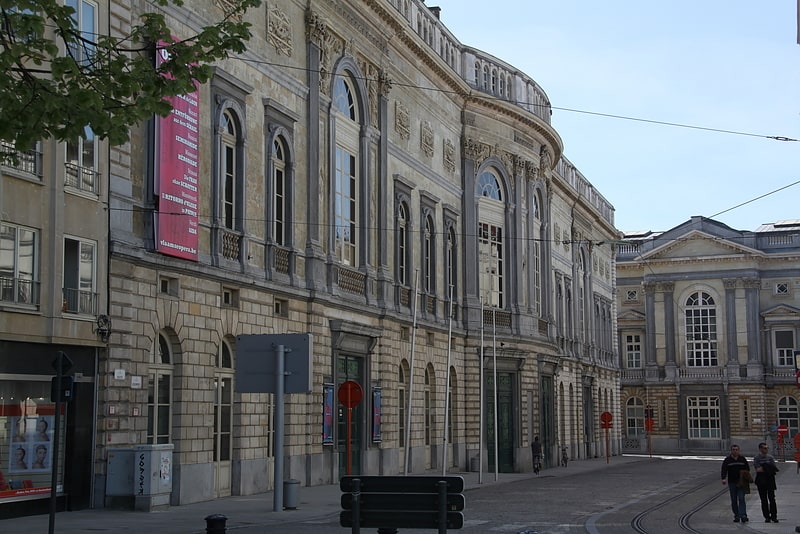
Also known as: Opéra flamand
Opera company. The Vlaamse Opera is an opera company in Belgium directed by Jan Vandenhouwe which operates in two different opera houses in two Flemish cities, the Vlaamse Opera Antwerp at Van Ertbornstraat 8 and the Vlaamse Opera Ghent at Schouwburgstraat 3. However, the company shares one orchestra, choir, technical team, etc. The organization is mainly financed by the Flemish government and the city councils of Antwerp and Ghent.
In its current form, the company was created in 1996 as a successor to the Flemish Opera Foundation (Vlaamse Opera Stichting, which had existed since 1988), and the Opera for Flanders (Opera voor Vlaanderen, which had existed since 1981). Both former institutions were similar fusions between the former opera houses of Antwerp and Ghent. Since the fusion in 1981, the company has been giving performances in two different historic theatres.[20]
Address: Schouwburgstraat 3, 9000 Ghent (Binnenstad)
Vrijdagmarkt
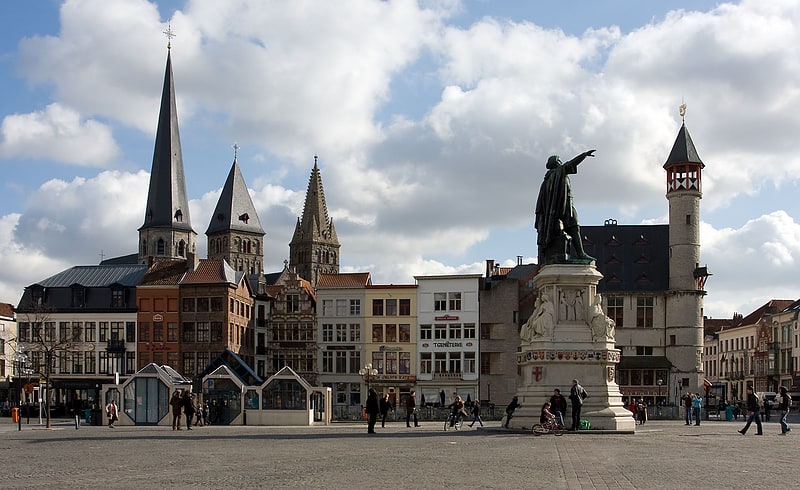
Tourist attraction in Ghent, Belgium. Vrijdagmarkt is a city square in the historic center of Ghent, Belgium. It is named after the weekly tradition to stage a market every Friday morning. As one of the oldest squares in Ghent, it played an important role in the city's history.[21]
Vooruit
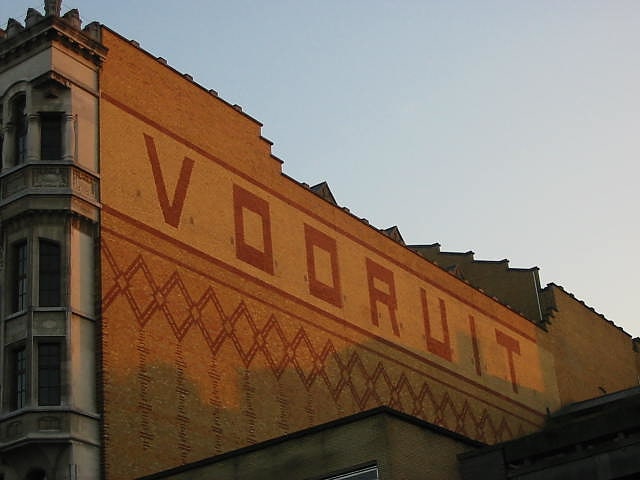
Theater in Ghent, Belgium. Vooruit is an historic complex in Ghent, Belgium. Vooruit was originally the festival and art center of the Ghent-based labor movement, with a ballroom, cinema, theater, etc. It is now mainly used for concerts and other cultural events.[22]
Address: Sint-Pietersnieuwstraat 23, 9000 Ghent (Binnenstad)
Familiepark Harry Malter

Amusement park, Theme park, Playground, Zoo
Address: Bosheidestraat 15, 9070 Destelbergen
De Krook
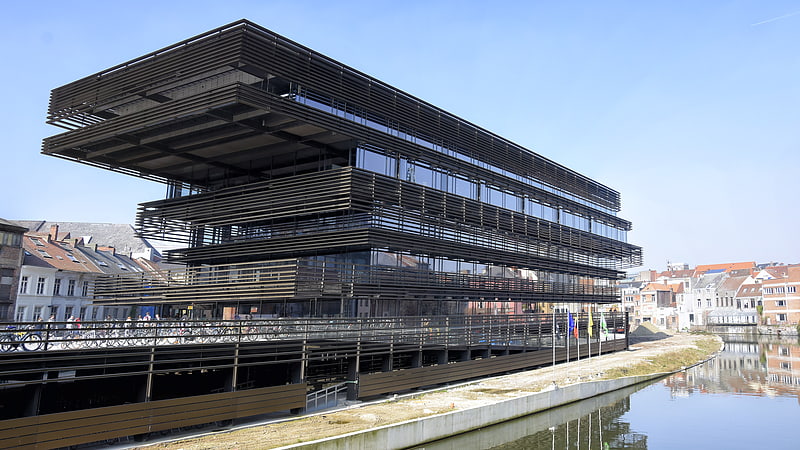
De Krook is a library and media center in Ghent, East Flanders, Belgium. It is an initiative of the city of Ghent, Ghent University and IMEC, and describes itself as "a place of inspiration for knowledge, culture and innovation" in the city. The library opened its doors on 10 March 2017, though construction was not fully completed until a year later. Its name refers to the curve of the river Scheldt that wraps around the northern and eastern sides of the site, and to its district, the Waalse Krook.[23]
Saint Peter's Abbey
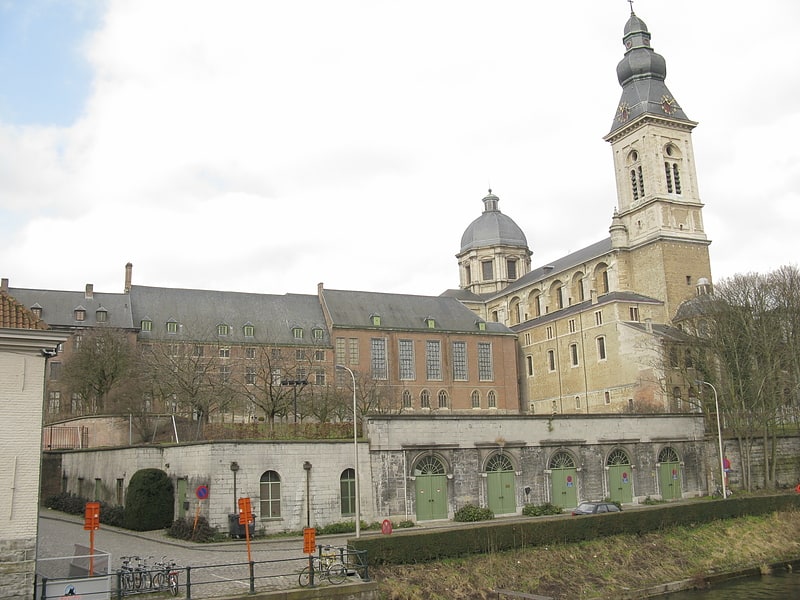
Also known as: Abbaye Saint-Pierre de Gand
Abbey in Ghent, Belgium. Saint Peter's Abbey is a former Benedictine abbey in Ghent, Belgium, now a museum and exhibition centre.
Saint Peter's was founded in the late 7th century by Amandus, a missionary sent by the Frankish kings to Christianize the pagan inhabitants of the region, who founded two monasteries in the area, St. Bavo's, and Saint Peter's on the Blandijnberg. During the winter of 879-80, the abbey was raided and plundered by the Normans, and it remained relatively poor until the 10th century, when donations of property and relics by Count Arnulf I considerably enriched it, as did further donations by Arnulf's cousin King Edgar of England. By the second half of the century it was the wealthiest abbey in Flanders, and the reputation of the abbey school extended far beyond the town. In 984, Gerbert of Aurillac, director of the cathedral school of Reims, (later Pope Sylvester II) inquired whether students from Reims could be admitted to Saint Peter's, and its renown as a centre of artes liberales continued into the 11th century. Saint Peter's, through its ownership of large tracts of land, also played a pioneering role in cultivation during the twelfth and thirteenth centuries, transforming forests, moors and marshes into farmland. In the fifteenth century a large scale programme of construction created the abbey library and scriptorium, enlarged the refectory, and the abbey church and other buildings were considerably beautified.
Saint Peter's first decline began following the Revolt of Ghent in 1539, and by the 1560s the Low Countries were plunged in a religious crisis that resulted in an attack by iconoclasts in 1566 in which the abbey church was wrecked, the library looted, and other buildings badly damaged. The infirmary was pressed into service as a temporary home for the monks and the refectory used as a place of worship. However opposition continued and in 1578 the abbot and monks were forced to flee to Douai. The abbey buildings were sold at public auction and were partly demolished, the materials being used to construct the city walls. The abbey finally came back into the hands of the church in 1584, and it was eventually rebuilt, with a new abbey church, begun in 1629, in the Baroque style, as well as several other new builds and refurbishments. During the 18th century, the abbey was once again flourishing, as new buildings were constructed and older ones enlarged, including the conversion of the old dormitory into a library with more than ten thousand books.
However, the end was not far off, first with the Brabant Revolution of 1789–90, then the French invasion of 1793. Finally, on 1 September 1796, the Directory abolished all religious institutions. In 1798 the library was emptied and eventually taken to the University of Ghent. From 1798 the abbey church was used as a museum, but was returned to the ownership of the church in 1801 and renamed Onze-Lieve-Vrouw-Sint-Pieterskerk ("Our Lady of Saint Peter's Church"). In 1810, the rest of the abbey became the property of the city of Ghent, and was partially demolished for the construction of a military barracks, which remained on the site until 1948.
Around 1950 the city launched a programme of restoration, which is still ongoing, which began with the cloister and chapter house, then the west wing, including the old refectory and kitchens. Work on the wine cellars and attics was completed in the 1970s, and in 1982 work on the abbey gardens was completed, and in 1986 the terrace. In the 1990s restoration of the refectory wing began.
The abbey is now used as a museum and exhibition centre, which in 2000 housed a major exhibition as part of the Year of Emperor Charles, and in October 2001 hosted the 88th meeting of the European Council.[24]
Address: Ghent, Sint-Pietersplein 9
Sint-Pietersplein
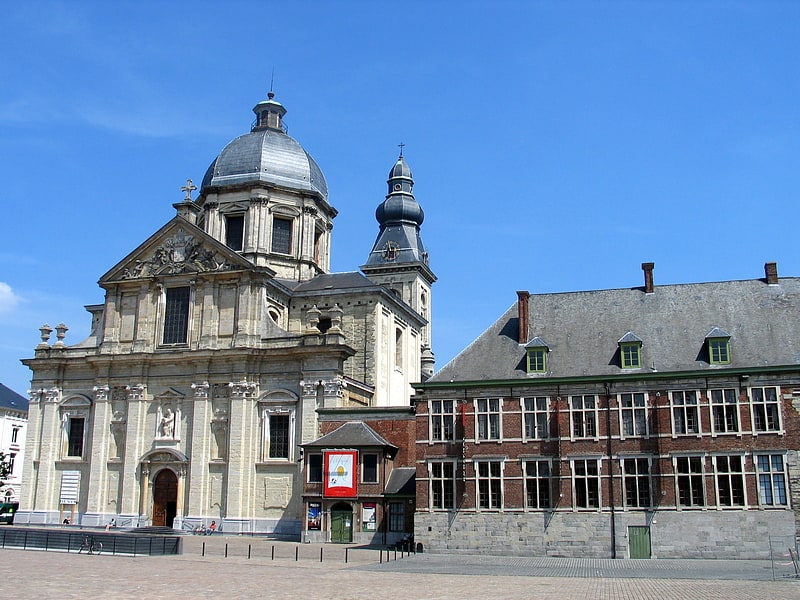
Sint-Pietersplein is a city square located in the south of the historic centre of Ghent, Belgium. The square is named after St. Peter's Abbey, which is located along its east side. It is Ghent's largest public square and a regular venue for cultural and sporting events, such as the annual Mid-Lent Fair in March. The square and its surrounding buildings are a protected cityscape.[25]
Saint Bavo's Abbey
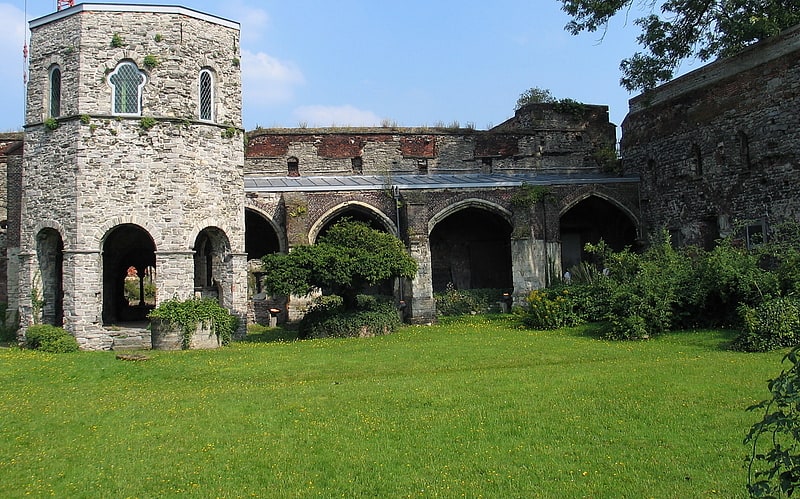
Also known as: Abbaye Saint-Bavon de Gand
Abbey in Ghent, Belgium. Saint Bavo's Abbey is a former abbey in the currently Belgian city of Ghent. It was founded in the 7th century by Saint Amand, who also founded Saint Peter's Abbey, Ghent, near the confluence of the Leie and Scheldt rivers. Originally, the abbey was also called Ganda, a name of Celtic origin, meaning "river mouth", referring to the Leie river debouching into the Scheldt river.
In the 9th century, the abbey was raided twice by Vikings, which made the monks flee to Laon. After an absence of nearly 50 years, they came back to Ghent and re-established the abbey. The German emperor Otto II saw the abbey as a strategical defense point on the Scheldt river (the former border between the Holy Roman Empire and West Francia) in his eternal conflict with Louis V of France.
Saint Bavo Church in Aardenburg, Netherlands, was founded by monks of the abbey in 959. John of Gaunt, the fourth son of Edward III of England, was born in the abbey in 1340.
In 1540 Charles V ordered the destruction of the abbey. A coercion castle, with its cannons directed at Ghent, was built on the location of the abbey.[26]
Address: Voorhoutkaai 43, 9000 Gent (Macharius-Heirnis)
Museum of Industry
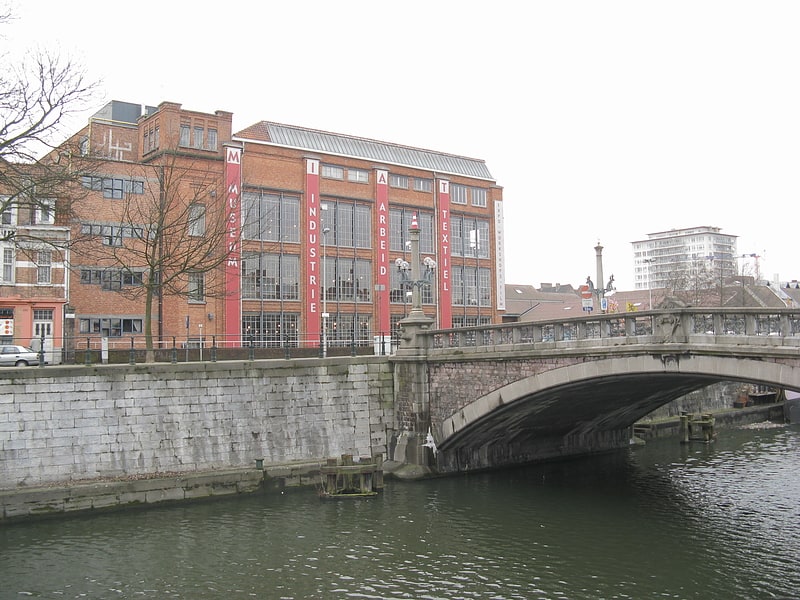
Also known as: Musée d'archéologie industrielle et du textile
Museum in Ghent, Belgium. The Museum of Industry, Work and Textiles is a museum in Ghent in Belgium. Ghent was at the centre of the Flanders textile region. The museum is an Anchor point on the European Route of Industrial Heritage.[27]
Address: Minnemeers 10, 9000 Gent (Binnenstad)
Drongen Abbey
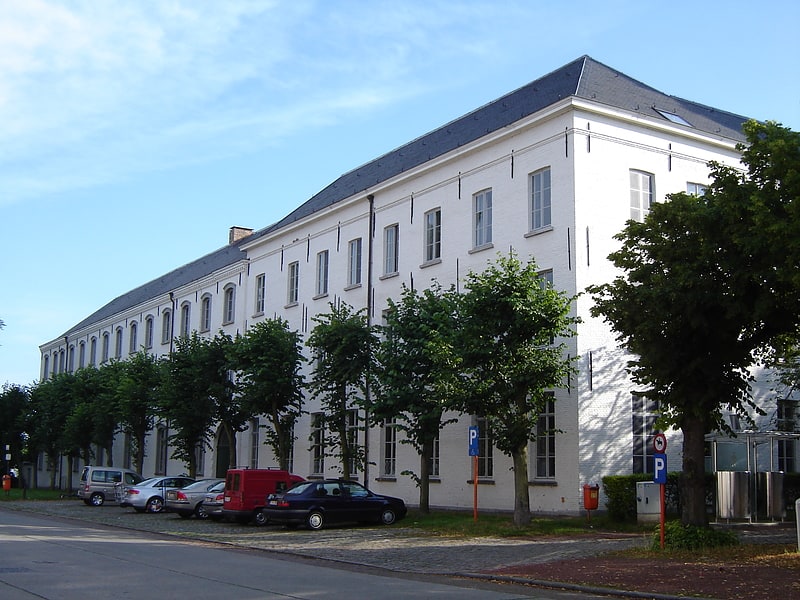
Also known as: Abbaye de Tronchiennes
Abbey. Drongen Abbey, or the Old Abbey, Drongen, is a monastic complex on the River Leie in Drongen, a part of the city of Ghent in East Flanders, Belgium.
Formerly a Premonstratensian abbey, since 1837 the premises have belonged to the Jesuits. In 1998 the whole property, including the garden, was declared a protected monument.[28]
Address: Drongenplein 26 - 27, 9031 Drongen (Drongen)
Campo Santo
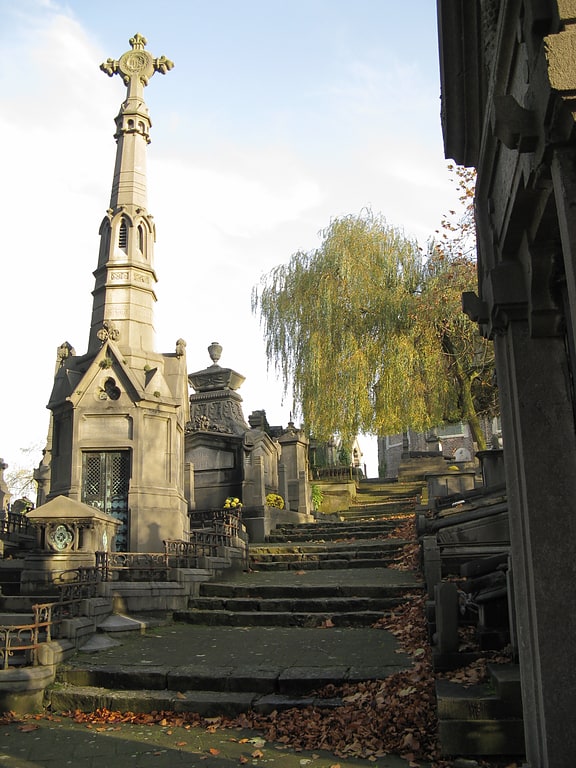
Burial ground. The Campo Santo of Ghent, Belgium, is a famous Roman Catholic public burial ground in Sint-Amandsberg. The Campo Santo has been declared an historical monument by the government. This cemetery is located in the district of Dampoort.[29]
Address: Visitatiestraat 13, 9040 Ghent (Sint-Amandsberg)
Oostakker Basilica
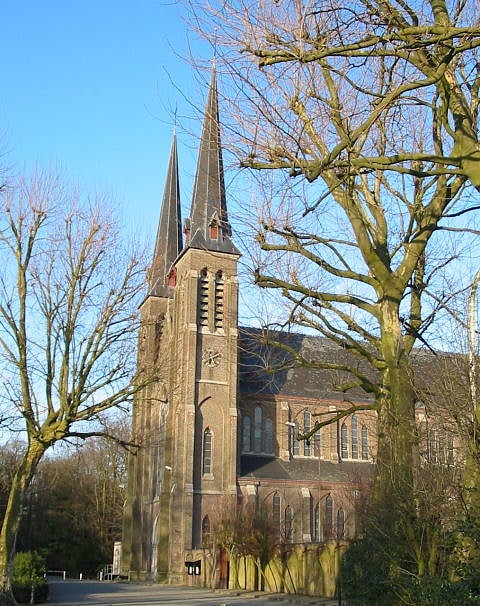
Also known as: Basilique Notre-Dame-de-Lourdes d'Oostakker
Catholic church in Ghent, Belgium. The Basilica of Our Lady of Lourdes is a Roman Catholic church at Oostakker, near Ghent in Belgium. Built in neogothic style at the end of the XIXe century it is the most important center of marian pilgrimage in Flanders.
In 1873 the Marquise of Courtebourne-de Nédonchel had a Lourdes grotto built in the gardens of her château at Slotendries. People from Ghent and other nearby locations asked to be allowed to visit the grotto and pray there, and it was claimed that in 1875 Pieter De Rudder was miraculously healed of a compound fracture.
To accommodate the resulting increase in the number of pilgrims, a neo-Gothic church based on plans by E. Van Hoecke-Peeters (slightly modified by J. B. Bethune) was completed in 1876 and consecrated in 1877. It was entrusted to the Jesuits, to which the Marquis's late son had belonged.
In one of the towers there is a carillon made up of 49 bells, cast by the Michiels Foundries in the 1950s. The keyboard was temporarily removed during renovation works in the 1970s but has not yet been replaced to this date.[30]
The Museum Dr. Guislain – a museum on the history of mental health
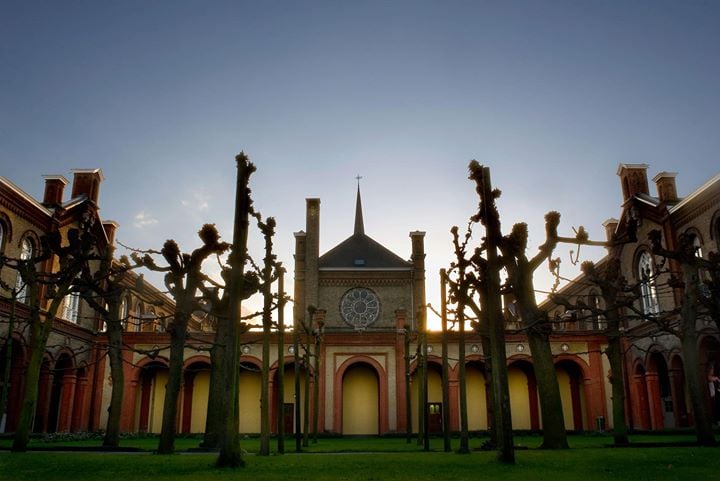
Museum, Specialty museum, Science museum
Address: Jozef Guislainstraat 43, 9000 Ghent (Bloemekenswijk)
Groot Begijnhof Sint-Amandsberg

The Groot Begijnhof Sint-Amandsberg is an eight-hectare beguinage in the Sint-Amandsberg suburb just outside the centre of the Belgian city of Ghent. It was built between 1873 and 1874 on the abandonment of the Old Saint Elisabeth Beguinage in the city centre. There is also a third beguinage in Ghent, that of Our-Lady Ter Hooyen.[31]
Address: Engelbert Van Arenbergstraat or Jan Roomsstraat, Ghent
Korenlei
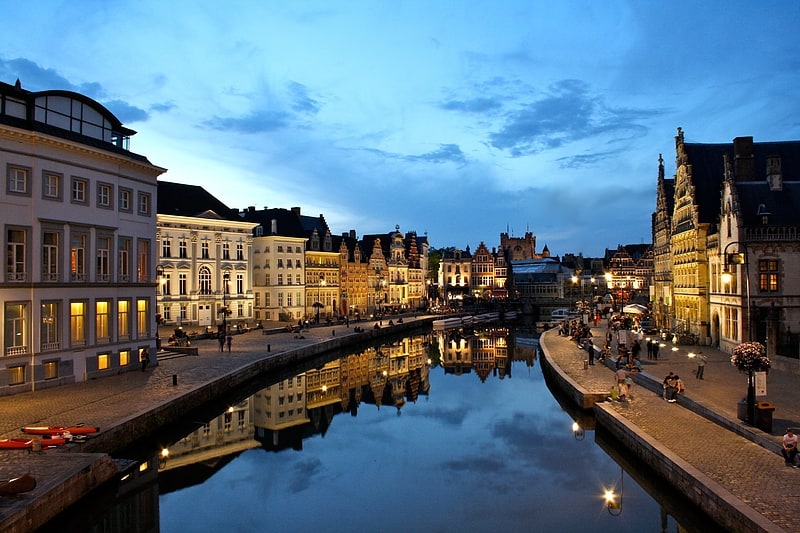
Historical landmark in Ghent, Belgium. Korenlei is a quay in the historic city center of Ghent, Belgium, located on the left bank of the Leie river. The quay on the opposite bank of the Leie is Graslei.[32]
Address: Sint-Michielsplein 21, 9000 Ghent (Sint-Elisabethbegijnhof-Prinsenhof-Papegaai-Sint-Michiels)
Boekentoren

The Boekentoren is a famous building located in Ghent, Belgium, designed by the Belgian architect Henry van de Velde. It is part of the Ghent University Library and currently houses 3 million books. The Boekentoren is directly adjacent to the Blandijn, the buildings of the Faculty of Arts and Philosophy.[33]
Address: Rozier 9, 9000 Ghent (Binnenstad)